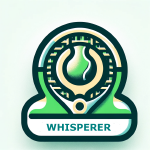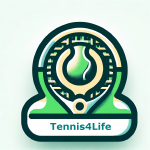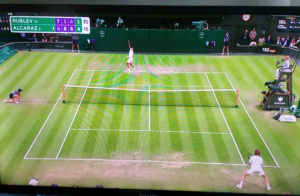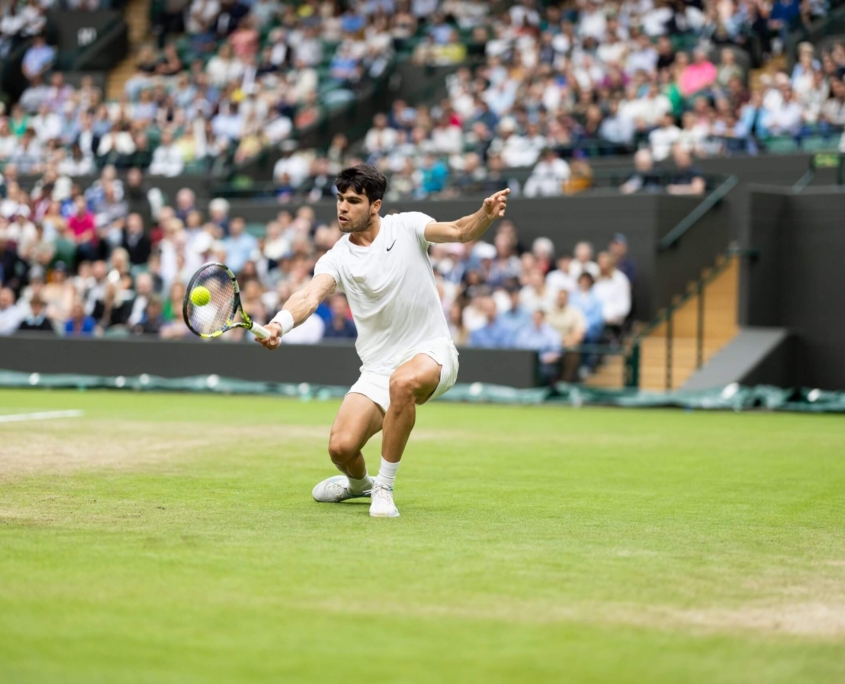Sinner’s Wimbledon Masterclass: Serve +1 Strategy
Sinner’s Wimbledon Masterclass: Serve +1 Strategy
Jannik Sinner’s first Wimbledon title was a clinic in modern tactical execution. Facing Carlos Alcaraz — a player known for variety, finesse, and improvisation — Sinner imposed a relentless baseline rhythm built around the Serve +1 strategy, bending the match to his terms with clinical precision. But this wasn’t just a tactical win. The unusually hot English summer fundamentally reshaped the court conditions — transforming Wimbledon’s grass into something far more familiar to Sinner: a fast, hard-hitting surface.
Hard-Court Conditions on Grass
Wimbledon’s grass typically favors short points, touch volleys, and low slices. But under the blistering July sun, the courts dried out and hardened, accelerating ball speed and flattening out bounce. This shift muted the effect of Alcaraz’s signature variety — especially his drop shots and low slices — while increasing the pace of play.
Result? A grass-court match that played like a hard-court.
Serve +1: Designed for Speed and Precision
Sinner capitalized with a textbook Serve +1 formula:
-
First-serve percentage jumped from 55% to 67%
-
Forehand aggression off the return became automatic
-
Court positioning stayed tight to the baseline, robbing Alcaraz of time
With Alcaraz unable to disrupt rhythm through touch or angles, the match became a banging contest.
The Turning Point
Despite a near-flawless first set, Sinner found himself a set down. Alcaraz’s ability to conjure magic from awkward positions — especially with slices and drop shots — initially left Sinner reacting.
Then came the shift. Sinner’s first-serve efficiency surged, and he began hunting forehands immediately after serve, flipping the dynamic and taking control of rallies from the outset.
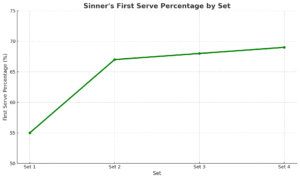
The numbers back it up. As the match progressed, Sinner’s Serve +1 efficiency became even more pronounced. He increased his attack percentage from 25% in the first set to 38% in the second and 40% in the third, reflecting not just a rise in first serves landed, but also in how effectively he followed them up with aggressive forehands.
By the fourth set, he was winning 47% of baseline points, a figure that flipped the script on Alcaraz, who had previously dominated grass with variety and control.
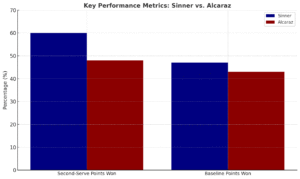
Serve +1 in Action: Control the Tempo
At its core, Serve +1 is simple but deadly:
-
Start with a reliable first serve to stretch or jam the returner
-
Move into the court to position for a forehand
-
Choose your target — inside-out or inside-in — and commit
Sinner executed this pattern ruthlessly and relentlessly. He didn’t wait for rhythm — he created it, repeatedly striking clean forehands off shallow returns to dismantle Alcaraz’s patterns.
Out-Alcarazing
The true breakthrough wasn’t just on serve — it was how Sinner handled second serves:
-
He stayed aggressive, both serving and returning
-
He turned Alcaraz’s second serve into a launchpad for plus-one aggression
-
His second-serve win percentage climbed, outpacing Alcaraz’s by the final two sets
Each aggressive return disrupted Alcaraz’s ability to build points — a subtle, sustained form of pressure that paid dividends.
Hard Court on Grass
Why did this strategy work so well?
-
Alcaraz’s drop shots repeatedly misfired, partly due to Sinner’s court coverage and balance
-
With touch neutralized, baseline rallies defined the match
-
Sinner’s footwork and balance — honed for hard court — allowed him to explode into shots without overplaying
Sinner didn’t just adjust to the surface — he used it to full advantage.
Wrap
Serve +1 isn’t just a strategy — it’s a mindset. Be first. Be decisive. Be in control.

